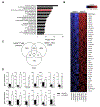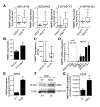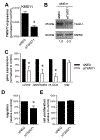Twist-1 is upregulated by NSD2 and contributes to tumour dissemination and an epithelial-mesenchymal transition-like gene expression signature in t(4;14)-positive multiple myeloma
- PMID: 32014459
- PMCID: PMC7829063
- DOI: 10.1016/j.canlet.2020.01.040
Twist-1 is upregulated by NSD2 and contributes to tumour dissemination and an epithelial-mesenchymal transition-like gene expression signature in t(4;14)-positive multiple myeloma
Abstract
Approximately 15% of patients with multiple myeloma (MM) harbour the t(4;14) chromosomal translocation, leading to the overexpression of the histone methyltransferase NSD2. Patients with this translocation display increased tumour dissemination, accelerated disease progression and rapid relapse. Using publicly available gene expression profile data from NSD2high (n = 135) and NSD2low (n = 878) MM patients, we identified 39 epithelial-mesenchymal transition (EMT)-associated genes which are overexpressed in NSD2high MM plasma cells. In addition, our analyses identified Twist-1 as a key transcription factor upregulated in NSD2high MM patients and t(4;14)-positive cell lines. Overexpression and knockdown studies confirmed that Twist-1 is involved in driving the expression of EMT-associated genes in the human MM cell line KMS11 and promoted the migration of myeloma cell lines in vitro. Notably, Twist-1 overexpression in the mouse MM cell line 5TGM1 significantly increased tumour dissemination in an intratibial tumour model. These findings demonstrate that Twist-1, downstream of NSD2, contributes to the induction of an EMT-like signature in t(4;14)-positive MM and enhances the dissemination of MM plasma cells in vivo, which may, in part, explain the aggressive disease features associated with t(4;14)-positive MM.
Keywords: Dissemination; Epithelial-mesenchymal transition; Multiple myeloma; NSD2; Twist-1.
Copyright © 2020 Elsevier B.V. All rights reserved.
Conflict of interest statement
Declaration of competing interest All authors declare no competing financial interests.
Figures




Similar articles
-
NSD2-epigenomic reprogramming and maintenance of plasma cell phenotype in t(4;14) myeloma.Oncotarget. 2025 Mar 21;16:220-229. doi: 10.18632/oncotarget.28706. Oncotarget. 2025. PMID: 40116454 Free PMC article.
-
SMARCA2 Is a Novel Interactor of NSD2 and Regulates Prometastatic PTP4A3 through Chromatin Remodeling in t(4;14) Multiple Myeloma.Cancer Res. 2021 May 1;81(9):2332-2344. doi: 10.1158/0008-5472.CAN-20-2946. Epub 2021 Feb 18. Cancer Res. 2021. PMID: 33602783
-
NSD2 is recruited through its PHD domain to oncogenic gene loci to drive multiple myeloma.Cancer Res. 2013 Oct 15;73(20):6277-88. doi: 10.1158/0008-5472.CAN-13-1000. Epub 2013 Aug 26. Cancer Res. 2013. PMID: 23980095
-
AKT-ions with a TWIST between EMT and MET.Oncotarget. 2016 Sep 20;7(38):62767-62777. doi: 10.18632/oncotarget.11232. Oncotarget. 2016. PMID: 27623213 Free PMC article. Review.
-
Ten years and counting: so what do we know about t(4;14)(p16;q32) multiple myeloma.Leuk Lymphoma. 2006 Nov;47(11):2289-300. doi: 10.1080/10428190600822128. Leuk Lymphoma. 2006. PMID: 17107900 Review.
Cited by
-
RAB22A as a predictor of exosome secretion in the progression and relapse of multiple myeloma.Aging (Albany NY). 2024 Mar 1;16(5):4169-4190. doi: 10.18632/aging.205565. Epub 2024 Mar 1. Aging (Albany NY). 2024. PMID: 38431306 Free PMC article.
-
The Role of Methyltransferase NSD2 as a Potential Oncogene in Human Solid Tumors.Onco Targets Ther. 2020 Jul 13;13:6837-6846. doi: 10.2147/OTT.S259873. eCollection 2020. Onco Targets Ther. 2020. PMID: 32764971 Free PMC article. Review.
-
An "unexpected" role for EMT transcription factors in hematological development and malignancy.Front Immunol. 2023 Aug 3;14:1207360. doi: 10.3389/fimmu.2023.1207360. eCollection 2023. Front Immunol. 2023. PMID: 37600794 Free PMC article. Review.
-
Circular RNA PLCE1 promotes epithelial mesenchymal transformation, glycolysis in colorectal cancer and M2 polarization of tumor-associated macrophages.Bioengineered. 2022 Mar;13(3):6243-6256. doi: 10.1080/21655979.2021.2003929. Bioengineered. 2022. PMID: 35349390 Free PMC article.
-
Exploring the Role of Epithelial-Mesenchymal Transcriptional Factors Involved in Hematological Malignancy and Solid Tumors: A Systematic Review.Cancers (Basel). 2025 Feb 5;17(3):529. doi: 10.3390/cancers17030529. Cancers (Basel). 2025. PMID: 39941895 Free PMC article. Review.
References
-
- Dutta AK, Hewett DR, Fink JL, Grady JP, Zannettino ACW, Cutting edge genomics reveal new insights into tumour development, disease progression and therapeutic impacts in multiple myeloma, Br. J. Haematol, (2017). - PubMed
-
- Rawstron AC, Owen RG, Davies FE, Johnson RJ, Jones RA, Richards SJ, Evans PA, Child JA, Smith GM, Jack AS, Morgan GJ, Circulating plasma cells in multiple myeloma: characterization and correlation with disease stage, Br J Haematol, 97 (1997) 46–55. - PubMed
-
- Bergsagel PL, Kuehl WM, Chromosome translocations in multiple myeloma, Oncogene, 20 (2001) 5611–5622. - PubMed
Publication types
MeSH terms
Substances
Grants and funding
LinkOut - more resources
Full Text Sources
Medical

